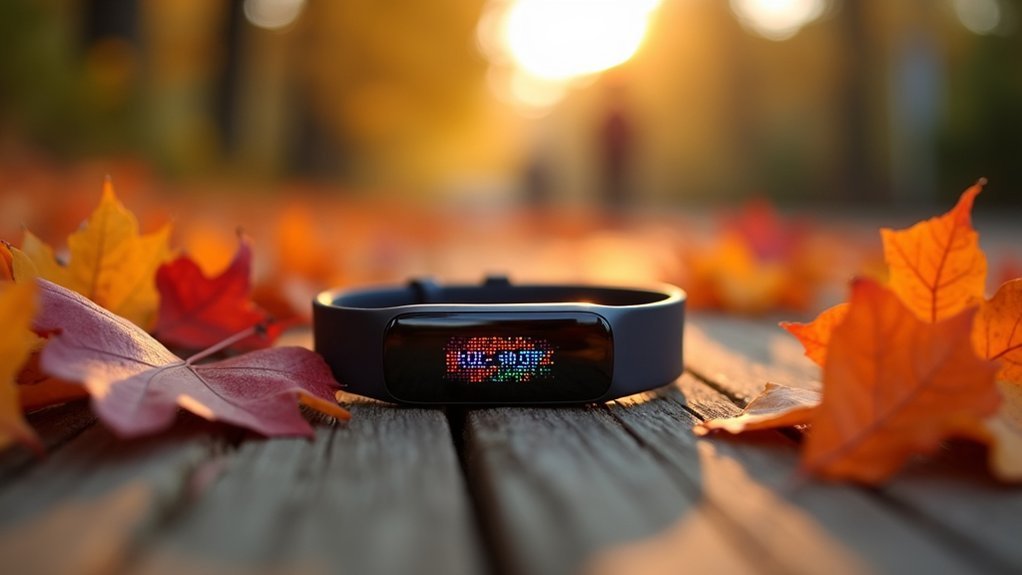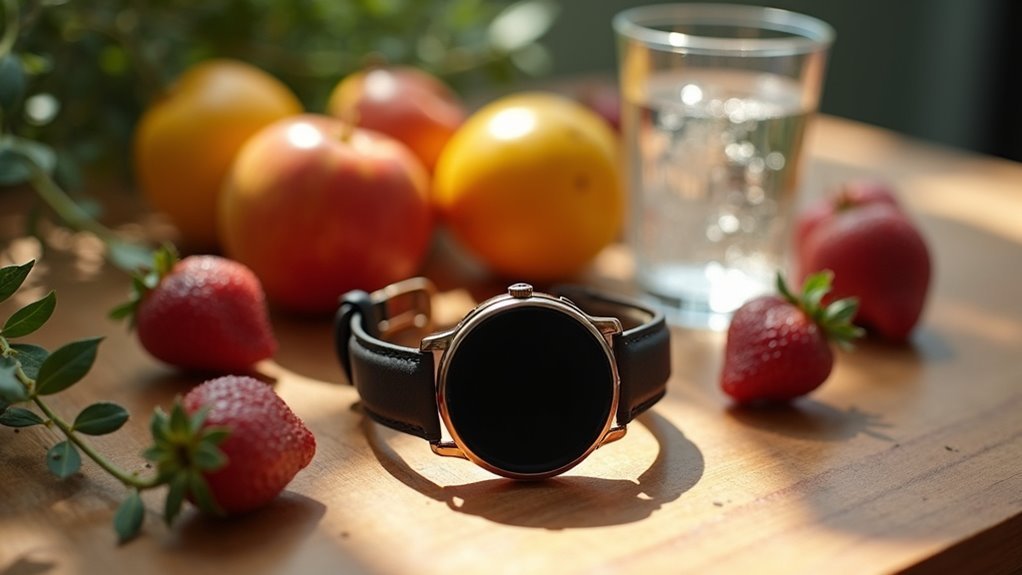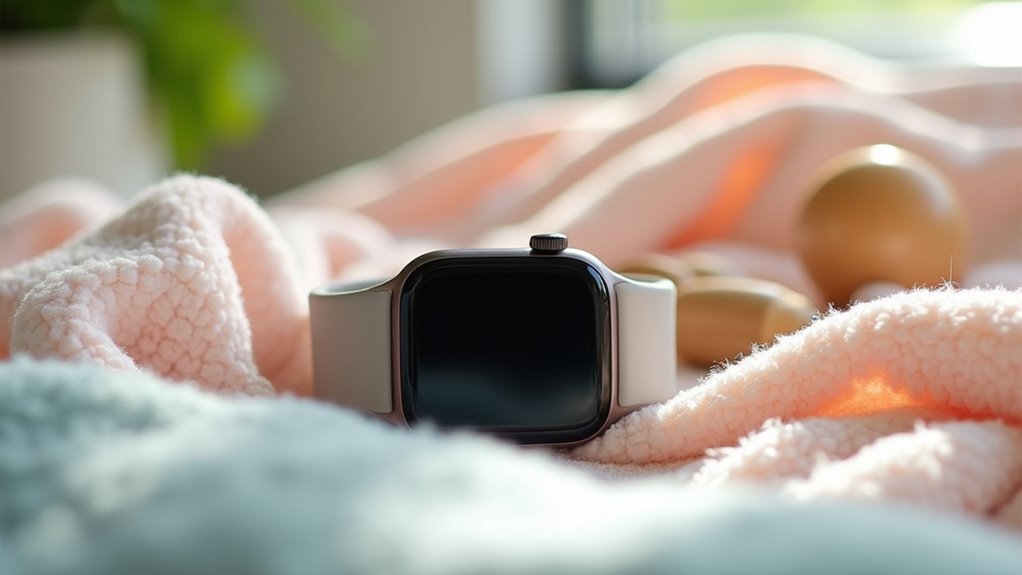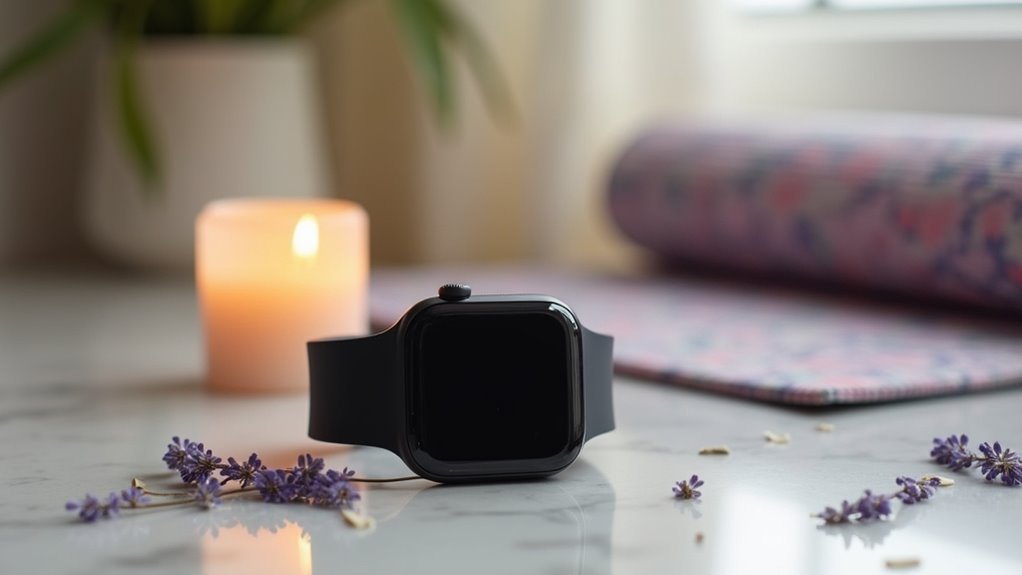You’ll want to take into account the Apple Watch Series 10 or Samsung Galaxy Watch 7 for the most reliable fall detection, as they use advanced multi-sensor technology combining accelerometers, gyroscopes, and machine learning to achieve 90%+ accuracy rates. Budget-friendly options like FitVII PulseMax offer decent protection under $200, while Garmin’s Venu 3 provides excellent battery life for active users. These devices automatically contact emergency services and can share your GPS location when falls are detected, giving you peace of mind through customizable sensitivity settings that minimize false alarms while maintaining responsiveness to real emergencies.
Top-Rated Fall Detection Fitness Trackers and Smartwatches
Several top-rated fitness trackers and smartwatches now incorporate sophisticated fall detection technology, giving you peace of mind during workouts and daily activities.
Samsung’s Galaxy Watch 7 and Galaxy Watch Ultra lead the pack with advanced sensors that detect falls across various activities while integrating seamlessly with health monitoring features.
Samsung’s Galaxy Watch 7 and Ultra feature cutting-edge sensors for comprehensive fall detection during any activity.
Apple Watch Series 10 remains the most popular choice, offering automatic emergency SOS when you’re immobile after a hard fall.
For athletes, Garmin’s Venu 3 and Forerunner 265 provide specialized fall detection with extended battery life for training sessions.
Budget-conscious users can explore FitVII’s PulseMax and AegisFit models, which combine fall detection with thorough health monitoring at affordable prices under $200.
True medical alert smartwatches feature built-in cellular SIM cards that enable direct emergency communication without requiring a connected smartphone.
Essential Features That Make Fall Detection Effective
You’ll find that effective fall detection relies on three critical components that work together to save lives.
Automatic detection algorithms analyze your movement patterns in real-time, while multi-sensor technology integration combines data from accelerometers, gyroscopes, and motion sensors to accurately identify actual falls versus normal activities.
Emergency response connectivity then guarantees that help reaches you quickly by automatically contacting emergency services or your designated contacts with your precise location. False positives can occur during vigorous physical activities, so modern systems use machine learning to minimize unnecessary alerts while maintaining sensitivity to actual emergencies.
Automatic Detection Algorithms
When your fitness tracker detects a potential fall, sophisticated algorithms work behind the scenes to analyze multiple data streams and determine whether you’ve actually fallen or simply performed a vigorous movement.
These algorithms achieve impressive accuracy rates of 89% to 93% by examining prefall, fall, and postfall phases. They analyze sudden deceleration, impact spikes, and subsequent inactivity patterns to create a fall signature.
Your device’s algorithm considers your age, activity level, and movement patterns to personalize detection thresholds. This prevents false alarms when you’re jogging or jumping.
The system maintains high sensitivity rates of 77% to 82% while achieving up to 99% specificity, minimizing unnecessary alerts. Detection accuracy varies significantly based on fall direction, with algorithms showing better performance for falls occurring on the same side as your smartwatch placement.
Machine learning enhances pattern recognition, ensuring you’ll receive help when needed.
Multi-Sensor Technology Integration
While a single sensor might trigger false alarms, your fitness tracker’s multi-sensor approach creates a detailed detection system that dramatically improves accuracy.
Your device combines accelerometers and gyroscopes to analyze movement patterns, distinguishing between everyday activities and actual falls. Heart rate monitoring adds another layer by detecting abnormal cardiovascular responses during incidents.
GPS integration enables real-time location sharing, ensuring emergency responders can find you quickly. Blood oxygen monitoring provides vital health data, particularly valuable if you have respiratory conditions.
Strategic sensor placement on your trunk, foot, or leg maximizes detection precision. Advanced systems also provide automatic SOS calling to your pre-set emergency contacts when a fall is detected.
This continuous monitoring doesn’t just detect falls—it assesses your fall risk and provides extensive health insights. The integrated approach transforms your fitness tracker into a sophisticated safety device that adapts to your specific needs.
Emergency Response Connectivity
Three critical seconds can determine whether your fall detection system saves your life or fails when you need it most. Your device’s emergency response connectivity transforms a detected fall into immediate action, automatically contacting your designated emergency contacts and sharing your exact GPS location.
| Response Feature | Timeframe | Benefit |
|---|---|---|
| False alarm cancellation | 30-60 seconds | Prevents unnecessary alerts |
| Emergency contact alerts | Within 60 seconds | Guarantees rapid response |
| 911 service connection | 2-3 minutes if no response | Professional emergency care |
| Location transmission | Immediate with alert | Enables quick assistance |
Advanced models operate independently through LTE/4G connectivity, guaranteeing alerts reach help even without your smartphone nearby. You’ll receive audible warnings before external alerts activate, while professional monitoring centers provide 24/7 oversight for premium models. Most fall detection systems require manual activation through the companion app before they become operational, so ensure this feature is enabled during initial setup.
Accuracy and False Alarm Management in Wearable Devices
You’ll want to understand how modern fall detection trackers balance accuracy with practical everyday use.
These devices employ sophisticated multi-sensor systems that combine accelerometers, gyroscopes, and sometimes barometers to distinguish between actual falls and routine activities like sitting down quickly. Research indicates that advanced fall detection systems can achieve 93% accuracy in identifying genuine fall events, demonstrating significant promise for real-world safety applications.
You can customize sensitivity settings and implement proven false alarm reduction strategies to guarantee your device responds appropriately to real emergencies while minimizing unnecessary alerts.
False Alarm Reduction Strategies
False alarm reduction represents one of the most critical challenges in wearable fall detection technology, as even highly accurate devices can generate dozens of unnecessary alerts monthly.
You’ll find that strategic device placement greatly impacts false alarm rates—positioning sensors on your trunk, foot, or leg can achieve up to 98% accuracy while reducing wrist-based misinterpretations from vigorous hand movements like clapping.
Modern algorithms enhance precision through activity context recognition, distinguishing between routine exercises and actual falls. Users frequently report false triggers during everyday activities like chopping food or putting on their watch.
Machine learning continuously adapts to your unique movement patterns, improving accuracy over time.
You can actively participate in false alarm reduction by testing your device regularly, reporting inaccurate alerts for algorithm refinement, and utilizing immediate dismissal options when false alarms occur.
Multi-Sensor Detection Technology
While optimizing algorithms and sensor placement can greatly reduce false alarms, the most effective approach combines multiple sensors working together to create an all-encompassing detection system.
You’ll find that multi-sensor fitness trackers integrate accelerometers, gyroscopes, heart rate monitors, and sometimes microphones to achieve up to 98% accuracy in fall detection. These systems don’t rely on a single sensor that might fail or misinterpret movement.
When you wear multi-sensor devices, they’re analyzing acceleration changes, rotational data, and physiological responses simultaneously. This redundancy means you’re less likely to experience false alarms from activities like sitting down quickly or exercising vigorously.
The real-time processing allows immediate alerts to emergency contacts, though you’ll need to take into account higher power consumption and potentially increased costs compared to single-sensor alternatives. Advanced systems incorporate machine learning models to continuously improve classification accuracy by analyzing patterns in your movement data and physiological responses.
Sensitivity Setting Customization
Modern fitness trackers put control directly in your hands through customizable sensitivity settings that let you fine-tune the balance between accurate fall detection and unwanted false alarms.
You’ll typically find sensitivity scaled numerically, with higher numbers indicating lower sensitivity to reduce accidental triggers. Default settings usually start mid-range between 6-8 on scales where 8 represents least sensitive.
You can adjust these settings through your device’s companion app under “Fall Detection” or “Safety & Emergency” sections, or directly on your watch.
Higher sensitivity catches more actual falls but increases false alarms, while lower settings reduce false positives but might miss softer falls. Keep in mind that high-impact activities may resemble a fall and trigger detection even with properly adjusted sensitivity settings.
Start with moderate sensitivity, then make iterative adjustments based on your false alarm frequency and activity patterns for peak performance.
Pricing Comparison and Value Analysis for Fall Detection Trackers
How much should you expect to invest in a fall detection fitness tracker, and which price point offers the best value for your needs? Entry-level trackers start around $50, like Xiaomi Mi Smart Band, but may lack reliable fall detection.
Mid-range options like SOS Smartwatch cost $111 plus $12 shipping, with $44.95 monthly monitoring fees. Premium devices such as Apple Watch Series 9/10 reach $499, offering extensive health features but requiring additional service plans.
You’ll face ongoing subscription costs of $20-$50 monthly for medical alert systems, with fall detection adding $10-$11 extra. Budget models sacrifice battery life and accuracy, while premium trackers provide 5-day battery life and advanced monitoring. Most budget fitness trackers focus on value for money while maintaining essential health monitoring capabilities.
Consider your activity level and safety needs when weighing upfront costs against monthly fees.
Integration With Emergency Response and Caregiver Systems
Beyond the initial purchase price and monthly fees, the true value of your fall detection tracker lies in how effectively it connects you with help when you need it most.
Modern systems integrate 24/7 monitoring centers that automatically dispatch emergency services upon fall detection. Devices like FallCall can wirelessly access smart doors for first responders and share real-time GPS location data.
You’ll benefit from extensive alert systems that notify both professional monitoring centers and designated family contacts simultaneously.
Many trackers work seamlessly with Apple Watch, smartphones, and smart home devices, creating a multi-platform safety ecosystem. Advanced fall detection technology can discriminate fall severities, helping reduce false alarms while ensuring genuine emergencies receive immediate response.
Advanced systems offer two-way communication and customizable alert thresholds, ensuring appropriate response levels while maintaining connection with healthcare providers for continuous care coordination.
User Experience Design for Daily Wear and Emergency Situations
When your life depends on a device, every design element matters—from the clarity of emergency buttons to the comfort of daily wear. Fall detection trackers must balance continuous monitoring with user-friendly interfaces that work seamlessly during both routine activities and crisis moments.
Effective user experience design incorporates three critical elements:
- High-contrast displays with large fonts – These improve visibility for elderly users with declining vision while reducing cognitive load during emergencies.
- Multi-modal feedback systems – Combining visual, tactile, and audio alerts guarantees you’ll receive critical notifications regardless of your current abilities or environment.
- Lightweight, ergonomic construction – Comfortable materials and adjustable bands encourage consistent daily wear while preventing sensor displacement.
Your tracker’s interface should prioritize emergency controls on primary screens while maintaining intuitive navigation for secondary functions like contact management and device settings. Leading manufacturers with 120 million users have demonstrated that successful fall detection devices require extensive testing across diverse age groups to ensure accessibility and reliability.
Choosing the Right Fall Detection Tracker for Your Needs
With dozens of fall detection trackers flooding the market, selecting the right device requires careful evaluation of your specific health needs, lifestyle, and technical preferences.
Consider whether you need LTE connectivity for smartphone-independent emergency alerts, or if basic Bluetooth pairing suffices. Evaluate your tolerance for false alarms—dedicated medical alert pendants offer superior accuracy but less versatility than smartwatches.
Budget-conscious users should factor in ongoing subscription fees for emergency response services. Regional limitations may restrict certain health features like blood pressure monitoring in the US.
Prioritize comfortable, wearable designs since consistent use determines effectiveness. Look for configurable alert windows and manual confirmation features to reduce false positives.
Choose devices with intuitive setup interfaces, especially if you’re less tech-savvy, ensuring you’ll actually use the safety features you’re paying for. Many fitness trackers offer extensive testing for accuracy and durability, which is crucial for fall detection reliability.
Frequently Asked Questions
Can Fall Detection Trackers Work Properly While Swimming or in Water?
You’ll find water-resistant fall detection trackers can function while swimming, but their underwater effectiveness isn’t well-documented. Water’s different fall mechanics may affect accuracy, so you shouldn’t rely completely on detection while swimming.
How Long Does the Battery Typically Last With Fall Detection Always On?
You’ll typically get 18-36 hours of battery life with fall detection always on. Popular smartwatches like Apple Watch and Samsung Galaxy Watch maintain this duration while continuously monitoring for falls using low-power sensors.
Will My Tracker Detect Falls if I’m Using a Wheelchair?
Your tracker’s fall detection might not work reliably in a wheelchair. These devices aren’t always sensitive enough to detect wheelchair falls, and the chair’s structure can interfere with sensors’ accuracy.
Can I Customize Which Contacts Receive Fall Detection Emergency Alerts?
You can customize emergency contacts on most fall detection trackers. iSmarch, Apple Watch, Samsung Galaxy, and FitVII all let you select specific contacts who’ll receive alerts when falls are detected.
Do Fall Detection Trackers Work Reliably During Sleep or Nighttime Hours?
Fall detection trackers work during sleep but aren’t perfectly reliable. You’ll experience frequent false alarms from normal sleep movements, while some genuine falls might go undetected due to sensor limitations and positioning.





Leave a Reply